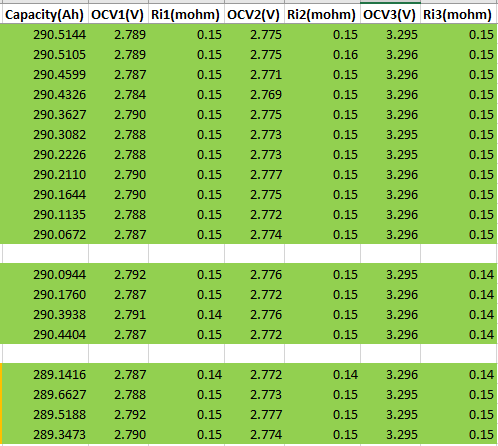If it doesn’t… I go back to questioning the quality of the BMS.
Sure, if you like playing with BMSes, by all means get a backup device to help you out every time the BMS leaves things in a mess ![]()
If it doesn’t… I go back to questioning the quality of the BMS.
Sure, if you like playing with BMSes, by all means get a backup device to help you out every time the BMS leaves things in a mess ![]()
YES … and the quality of the cell manufacturing … don’t forget that, the entire crux of the matter. ![]()
Must say, this 18-cell bank is doing its thing.
Details:
What we call a “dumb battery” on our end. As opposed to a “managed battery”. Used to be called a “smart battery” but then it got confusing because there are too may other smart things already, including a SmartLithium.
Is this not to low for the cells you have - I know you have told us before (in detail) but… ![]()
This was the other question - why not let the Cerbo do it’s thing… ?
Because of this:
Bank tends to go to 3.49v-3.50v when charging flat out, till Victron pulls back eloquently.
My “personal best”, inverter using Eskom, panels flat out, set to Keep Charged, is 128a DC charging. Far below the max the BMS and/or the cells can handle … just because for fun. (I got gatvol and wanted them charged NOW!)
Yes, Louis has the driver, but why have more complications in there if it is not needed? If what is works?
If the cells get older and start having issues, AFTER a Top Balance session or two, the next move is a NEEY balancer. Those things do their thing, as Andy demonstrated.
After that Louis’s driver will be activated as a last resort.
The “secret”? Grade A Batch Matched cells.
If they were not behaving so nicely, read lower quality cells, yes, I would have been running Louis driver on the Cerbo.
Delta when charging flat out can reach 0.080v. One cell, no 6, the hasty one. Too much effort to bother.
98% of the time, perfection.
Why charging so slow … one word: Weather!
FWIW: BMV says 50% now.
EDIT:
Cell 16-18 was added months after the other cells were running.
Took a while to bring them in line with the other 15 cells.
Allow me to nitpick a little. It’s not really that you waste “energy”. It’s rather that very little additional energy gets stored at the cost of a much higher cell voltage. The higher cell voltage makes everyone’s life more difficult, control loops have to react faster, etc etc. So you’re making a lot of work for yourself to get less than 1% extra storage. Plus, you slightly extend battery life by keeping the voltage lower.
Amen, give that man a Bells.
So the one day I wanted to know how much energy is now really in the batt, but doing it in the reverse.
Set the inverter to switch off at 2.9v, BMV set to Zero (0) SOC … system ran and ran and ran slowly heading for 3v … where I chickened out.
Why? If I get it wrong, and LS hits, I would be dead in the water at the time.
Realized there is a ton of wattage stored below 20% SOC.
… also used the opportunity to start balancing the cells from 3.1v upwards.
My point, it is not what is “on top”, it is what is “down below”.
SOC is a calc, as we all now know, best guess, an estimate based on parameters like coulomb counting and volts, as close as we can get it.
I swear if I were to set the system to run between 3v <----> 3.45v, I would get quite a surprise at the kWh stored in that range. Cells are sold as 280ah, but I know they are ±290ah.
Summer is coming, and I want to “play”.

I had a BYD battery down to 2.6V (lowest cell) once. I was testing the battery, wanted to push it down so low that it switches off, to see if it will black-start. Ie, system turns itself back on when the sun rises again. Some battery systems cannot black start, they need human intervention.
When I got to 2.6V, I also chickened out. Sent manufacturer an email… never heard if that was too low or not. For me, it was too low for comfort.
What can possibly go wrong?
SO I may, MAY, lose a couple of the claimed 6000 cycles. That is if I do. So what.
Or more interestingly, maybe the calibration can be more “accurate” afterward, for the BMS and BMV.
Maybe I must put in 290ah instead of 280ah …
Stretch the banks “legs a bit”. Push the envelope … know how far one can push it when the “chips are down”.
And Black-Start … a oeps moment … so what. It is a DIY bank. I’m the “master”. I’ll just point my finger at it and it will behave. ![]()
… I cannot see any way for things to go wrong badly … weather and LS schedules, being around when it gets that low, are the only 3 parameters.
Now that I think about this, maybe I must put the bank at 289ah.

And when it ages, then lower it as the cells age, for the calcs to better calc what is actually left.
I dread the thought, as Will and Andy speculated, that this bank dies of old age.
An oldie, but relevant.
Don’t break the stick to find out how strong it is.
Manufacturer says:
Don’t go to 2.6v (?).
Don’t go above 3.65v
… THAT is breaking the stick.
An old engineering adage:
If it is working leave it TF alone.
Essentially this one:

YES!!!
Don’t fix it if it ain’t broke.
Here are my questions:
Am I using the 18 cells to their full potential?
Are the calculations in and around the bank correct?
The only way to find that out … Nike! (Just Do It).
I mean, who said go for 18 cells? Who gave me that idea!? ![]()
Add some pliers and a bit of “blou draad” (heavy wire) and you have the perfect emergency kit for your car. ![]()
I do add a 500ml bottle water and old cloth as well. Have not broken down since…